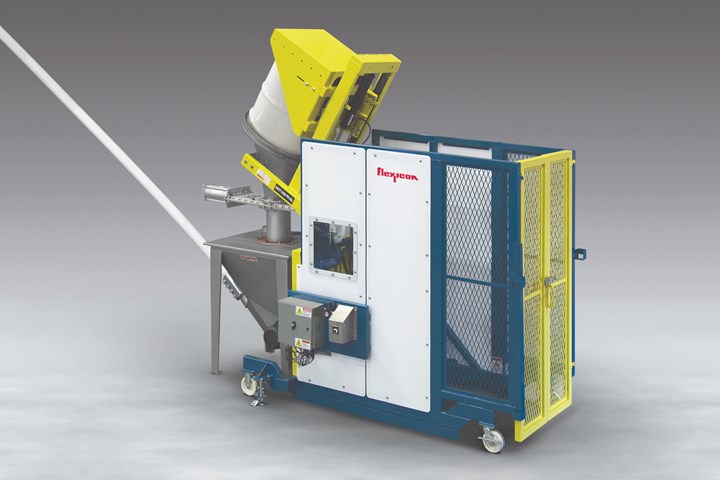Drum Dumper with Safety Cage
Allows hands-free, automated dumping of bulk solid materials from 30- to 55-gal drums.
Flexicon’s new mobile with safety cage allows hands-free, automated dumping of bulk solid materials from 30- to 55-gal drums throughout the plant, with no dusting or danger associated with sudden shifting of contents.
The three-sided carbon steel cage with safety interlocked doors is mounted on a mobile frame with quick-acting jack screws for stability. A platform raises the drum hydraulically, creating a dust-tight seal between the rim of the drum and the underside of a discharge cone.

A second hydraulic cylinder then tips the platform-hood assembly, stopping it at dump angles of 45, 60 or 90° with a motion-dampening feature, causing the spout of the discharge cone to mate with a gasketed receiving ring on the lid of an enclosed hopper that charges a flexible screw conveyor.
A pneumatically-actuated slide gate at the spout can be opened once the discharge cone has sealed to the receiving ring to discharge material, and then closed before returning the drum to its original position, with no dust emitted throughout the cycle.
Constructed of carbon steel with stainless steel material contact surfaces, the unit is also available in all-stainless steel finished to food, dairy or pharmaceutical standards. Optional cone adapters allow for safe, dust-tight dumping of small-diameter drums and pails.
Related Content
-
PTXPO Recap: Smarter Resin Drying & Conveying Automation
Check out what you missed on the PTXPO show floor. In this video, Editorial Director Jim Callari breaks down how AI is changing the game in plastics manufacturing.
-
Finding Efficiencies in How Components Work Together
Auxiliary systems are vital to the proper functioning of a plastic processing line, and they can be a source of major cost and efficiency improvements.
-
Processors: Gear Up to Handle More Regrind
Plastics auxiliary and primary processing equipment was optimized for running pellets; here’s how you can adjust to the bulk density differences of flake and regrind in drying, conveying, mixing, feeding and processing.




